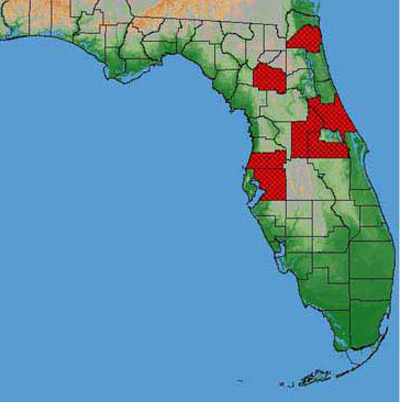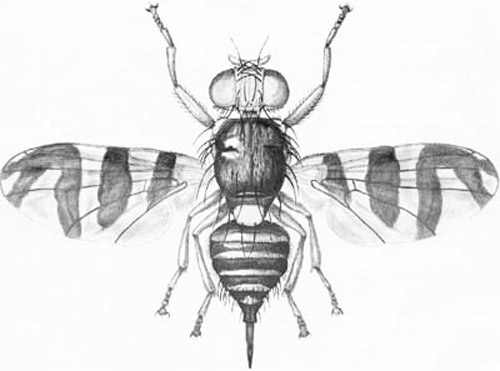common name: cherry fruit fly
scientific name: Rhagoletis cingulata (Loew) (Insecta: Diptera: Tephritidae)
Introduction - Synonymy - Distribution - Identification - Life History and Habits - Hosts - Selected References
Introduction (Back to Top)
The larvae of two closely related species of fruit flies in central and eastern North America — Rhagoletis cingulata (Loew), commonly called the cherry fruit fly (adult) or cherry maggot (larva); and Rhagoletis fausta (Osten Sacken), the black cherry fruit fly — attack cherry and cause wormy fruits. Only R. cingulata occurs in Florida, where it attacks wild cherries and is of little economic importance. Rhagoletis cingulata breeds in all varieties of cherries including the sweet cherry.
These two species closely resemble a third pest species, the apple maggot, Rhagoletis pomonella (Walsh). The adults of all three species have banded wings.
Synonymy (Back to Top)
Trypeta cingulata Loew, 1862
Distribution (Back to Top)
The cherry fruit fly, Rhagoletis cingulata (Loew), is found from Michigan to New Hampshire, southward to Florida, occurring over the entire middle and eastern region of the United States and also in southeastern and southcentral Canada. This species was also reported in Switzerland (1983) and northern Italy (1998), and is present in the cherry-growing area of Rhineland-Palatinate, Germany (1993), and the Netherlands (2001) (Lampe et al. 2005).
Figure 1. Reported distribution of the cherry fruit fly, Rhagoletis cingulata (Loew), in Florida. Figure by G. J. Steck and B. D. Sutton, Division of Plant Industry.
The western cherry fruit fly, Rhagoletis indifferens Curran, once considered a subspecies of Rhagoletis cingulata, occurs in the western United States from Idaho and Washington southward into California.
The black cherry fruit fly, Rhagoletis fausta (Osten Sacken), the third species in this complex, occurs across southern Canada southward to New York in the east and to California along the west coast.
Identification (Back to Top)
These flies are 4–5 mm long, just a little smaller than a house fly, and generally black with yellow margins on the thorax. The scutellum is white, the tibiae and tarsi are yellowish, and there are transverse and oblique blackish markings on the wings. The eastern cherry fruit fly has four white crossbands on the abdomen, which are not found on the black cherry fruit fly. The blackish bands on the wings of the black cherry fruit fly are more pronounced.
Figure 2. Adult female cherry fruit fly, Rhagoletis cingulata (Loew). Graphic by Division of Plant Industry.
The maggots found in the fruit are yellowish white, up to 1/4 inch long and—typical of fly larvae—are pointed at the head end. Key characters for the separation of the larval stage from related species are given by Phillips (1946).
A weevil, the plum curculio, Conotrachelus nenuphar (Herbst) is the most serious pest of cherries and plums, and its larvae may be mistaken for those of the fruit flies. However, plum curculio larvae have heavy chewing mandibles and a bluntly rounded head which readily distinguish them from fruit fly larvae which have sharp-pointed, downward-curved mouth hooks and a sharply pointed head.
Life History and Habits (Back to Top)
Adults emerge from the ground during the spring when cherries are about half grown and feed for a few days on materials on the surface of the leaves and fruit before laying eggs. This is the most vulnerable stage in the fruit fly life cycle and the best time for control. Each female may deposit 300 to 400 eggs. Only one larva matures in a fruit, although more than one egg may be deposited in a single fruit. After oviposition the eggs hatch in five to eight days, and the young larvae tunnel directly to the surface of the cherry seed. They pass through three instars at an average of 11 days at 77°F.
By the time the cherries are ripe, the larvae mature, drop to the ground, and burrow into the soil to a depth of one to three inches where they pupate and eventually overwinter. At first, infested cherries do not fall from the tree and may develop sunken areas. By harvest time as many as 75% of the cherries may be infested. Larvae are likely to be in the fruits of early varieties when harvested, and may pass undetected and be distributed around the country. A few flies emerge in August and September as a second generation, but about 99% require a year to complete a life cycle.
Hosts (Back to Top)
The primary hosts are cultivated cherries:
- Prunus avium, sweet cherry
- Prunus cerasus, sour cherry
- Prunus mahaleb, Mahaleb or St. Lucie cherry
- Prunus serotina, wild cherry.
Rhagoletis cingulata also has been reared from plum (Prunus spp.), fringe tree (Chionanthus virginica L.) and wild olive (Osmanthus americanus (L.) Gray).
Rhagoletis cingulata attacks both sweet and sour cherries while Rhagoletis fausta primarily attacks the sour cherries. Because both species are native to the United States, their original food must have been the wild species of cherry.
Selected References (Back to Top)
- Davidson RH, Peairs LM. 1966. Insect Pests of Farm, Garden, and Orchard. John Wiley & Sons, Inc., New York. 675 pp.
- Phillips VT. 1946. The biology and identification of trypetid larvae (Diptera: Trypetidae). Memoirs of the American Entomological Society 12: 161.
- Garman P, et al. 1956. Plant pest handbook. Connecticut Agricultural Experiment Station Bulletin 600: 1-194.
- Glasgow H. 1933. The host relations of our cherry fruit flies. Journal of Economic Entomology 26: 431-438.
- Metcalf CL, Flint WP, Metcalf RL. 1962. Destructive and Useful Insects, their Habits and Control. McGraw-Hill Book Co., Inc., New York. 1087 pp.
- Pelz-Stelinski KS, Gut LJ, Stelinski LL, Liburd OE, Isaccs R. 2005. Captures of Rhagoletis mendax and R. cingulata (Diptera: Tephritidae) on sticky traps are influenced by adjacent host fruit and fruit juice concentrates. Environmental Entomology 34: 1013-1018.
- Pelz-Stelinski KS, Gut LJ, Isaccs R. 2006. Vertical position of traps influences captures of eastern cherry fruit fly (Diptera: Tephritidae). Florida Entomologist 89: 80-82.
- Quayle HJ. 1941. Insects of Citrus and Other Subtropical Fruits. Comstock Publishing Co., Inc., Ithaca, New York. 583 pp.
- Stone Alan, et al. 1965. A Catalogue of the Diptera of America North of Mexico. USDA Agricultural Handbook No. 276. 1696 pp.
- White IM, Elson-Harris MM. 1994. Fruit Flies of Economic Significance: Their Identification and Bionomics. CAB International. Oxon, UK. 601 pp.

